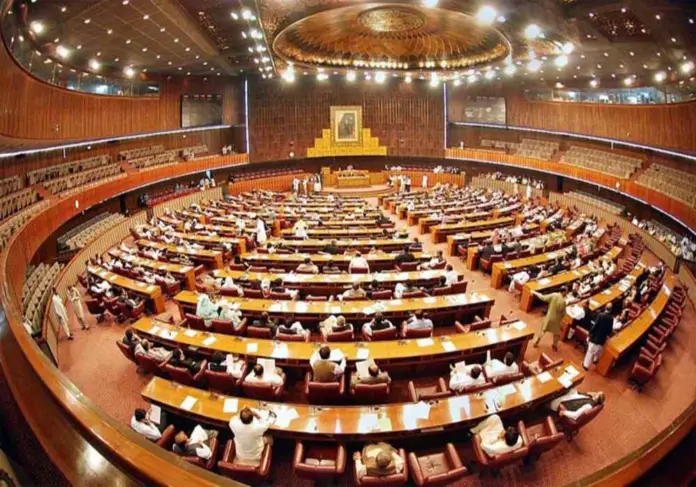In the November 17, 2021 joint session of parliament the Pakistan Peoples Party (PPP) co- chairman raised the objection that the bills passed by the House, especially those relating to voting through EVMs, right of vote to Pakistan expatriates in national elections, autonomy from govt. control to State Bank and right of review against death sentence awarded to an Indian spy, that these draft laws can not been considered lawfully passed as all bills in a joint session, under the Rules of Procedure of the Parliament, in order to be passed, require the votes of a majority of not those present and voting, but the total membership of the two houses taken together.
The speaker, upon a count, had announced that 221 members had voted in favour of the EVM bill with 203 against. The total membership of the two houses is 442 of which 342 and 100 relate to National Assembly (NA) and Senate respectively; therefore, according to the PPP leader, the bills required 222 votes. Since only 221 had been counted in favour of the bills, these cannot be regarded as passed as they fell one vote short of the majority.
Before the layman interprets the relevant law and rules it is worth mentioning that the Speaker, on the pointation of Senator Taj Haider (PPP) that in the count of the treasury votes, the advisors/SAPMs had also mistakenly been counted, ordered a recount that could not materialise in the ensuing mayhem between the govt and opposition benches. The real numbers supporting the bills were thus left undetermined.
Law Minister Farogh Nasim replying to Bilawal’s objection stated that sub clause (4) of Article 72 of the Constitution overrides any contrary provision of the rules and these govern the manner of taking decision on bills in a Joint session. This article, to wit, provides that, “72 (4) Subject to the Constitution, all decisions at a joint sitting shall be taken by the votes of the majority of the members present and voting.”
I took out my copy of the 1973 Constitution of Pakistan to relearn, as a layman, the content, context, phraseology and intent of the provisions of the constitution in respect of the method of passage of bills in a joint sitting of parliament.
A word of caution. As a novice to legal jargon and interpretation, no finality or authority is claimed in the posited understanding of the issues involved. Yet this is being penned due to the quite apparent and clear points, which do not seem to appeal to a common person’s mind.
A number of questions arise in the uninitiated mind. How is it that the rules governing procedures of a joint session can for such a long period remain in apparent contradiction to the provisions of the constitution?
The rules governing joint session of parliament are formulated under a special and specific provision of the constitution i.e. under its article 72 in which the president, after consultation with the Speaker and the Chairman, lays these rules before a joint session of Parliament, which after considering them approves the same. How is it possible that rules formulated after such highfalutin and serious scrutiny and confabulations can subsist contrary to the constitution in respect of a fundamentally crucial matter regarding the manner in which bills are to be approved in a joint session of parliament?
Is it that different provisions exist in the constitution regarding the voting method in a joint session to approve bills?
And those relating to approval of the Rules of Procedure concerning the joint session. And is it possible that the learned law minister quoted not the substantive provisions governing voting procedure in a joint session but mistakenly read out the enactment relating to the method of approval of the Rules of Procedure.
To untie this seeming Gordian knot let us go to article 70 of the constitution. After laying down the procedure regarding the passage of a bill by either house of parliament, the article in its sub article ( 3) spells out that in case a bill on being passed by one house is either rejected or not passed for 90 days by the other house, the original house may request for the bill “to be considered in joint sitting” (Sub article (2) of Article 70).
This is followed by article 70 sub article (3), the substantive provision of the constitution governing the mode of vote on a bill in a joint session. It is reproduced as follows:
“Art.70(3) If a request is made under clause (2), the President shall summon a joint sitting; and , if the Bill is passed in the joint sitting, with or without amendment, by the votes of the majority of the total membership of the two Houses, it shall be presented to the President for assent.”
Given the above unequivocal constitutional provision what can one make of the provision quoted by the law minister in the joint session as contained in Article 72 (4) which reads, “Subject to the Constitution, all decisions at a joint sitting shall be taken by the majority of the members present and voting.”
It is obvious that two apparently conflicting provisions cannot exist in the constitution regarding the voting method for passage of bills laid before a joint session of parliament: one stipulating that a bill shall be passed by a majority of the members of both the houses (Art.70 (3)) and the other (Art.72(4)) stating a bill requires to be passed by a majority of the members present and voting. Only one can be applicable to the bills that have been passed by the joint session held last week.
This mystery is perhaps explained if one looks at the context in which these two apparently contradictory provisions exist and must be read and understood.
Whereas Article 70 relates to “Introduction and passing of bills by either house or in a joint session of Parliament, Article 72 is titled, “72. Procedure at joint sittings.” A plain reading of article 72 shows that, “72 (1) the president, after consultation with the Speaker of the National Assembly and the Chairman, may make rules as to the procedure with respect to the joint sittings of, and communication between the two Houses.”
After explaining as to who will chair such a specific joint sitting and how amendments may be made in these rules, in Article 72 (4) the constitution lays down that these rules shall be passed by the majority of the members present and voting.
It thus becomes clear that the provision of the constitution that the law minister quoted in the joint sitting to counter the opposition’s contention was rather misplaced. It would appear that the votes secured by the bills were one short to make a majority vote of 222 out of the “votes of the majority of the total membership of both the two Houses”. The Law Minister placed before the joint session a provision that applies to the constitutional procedure for approval of rules of procedure regarding joint sittings rather than those applying to approval of bills in a joint sitting. That this was accepted as authoritative by the learned speaker without demur is rather difficult to explain in a lay person’s language.







